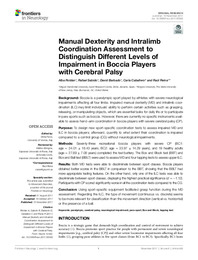Título :
Manual Dexterity and Intralimb Coordination Assessment to Distinguish Different Levels of Impairment in Boccia Players with Cerebral Palsy |
Autor :
Roldan, Alba
Sabido, Rafael 
Barbado, David
Caballero, Carla  |
Editor :
Frontiers Media |
Departamento:
Departamentos de la UMH::Ciencias del Deporte |
Fecha de publicación:
2017-11-10 |
URI :
https://hdl.handle.net/11000/30898 |
Resumen :
Background: Boccia is a paralympic sport played by athletes with severe neurological
impairments affecting all four limbs. Impaired manual dexterity (MD) and intralimb coordination
(ILC) may limit individuals’ ability to perform certain activities such as grasping,
releasing, or manipulating objects, which are essential tasks for daily life or to participate
in para sports such as boccia. However, there are currently no specific instruments available
to assess hand–arm coordination in boccia players with severe cerebral palsy (CP).
Purpose: To design new sport-specific coordination tests to assess impaired MD and
ILC in boccia players; afterward, quantify to what extent their coordination is impaired
compared to a control group (CG) without neurological impairments.
Methods: Seventy-three recreational boccia players with severe CP (BC1:
age = 34.01 ± 16.43 years; BC2: age = 33.97 ± 14.29 years), and 19 healthy adults
(age = 27.89 ± 7.08 years) completed the test battery. The Box and Block test (BBT) and
Box and Ball test (BBLT) were used to assess MD and four tapping tests to assess upper ILC.
results: Both MD tests were able to discriminate between sport classes. Boccia players
obtained better scores in the BBLT in comparison to the BBT, showing that the BBLT had
more appropriate testing features. On the other hand, only one of the ILC tests was able to
discriminate between sport classes, displaying the highest practical significance (d = −1.12).
Participants with CP scored significantly worse in all the coordination tests compared to the CG.
conclusion: Using sport-specific equipment facilitated grasp function during the MD
assessment. Regarding the ILC, the type of movement (continuous vs. discrete) seems
to be more relevant for classification than the movement direction (vertical vs. horizontal)
or the presence of a ball.
|
Palabras clave/Materias:
aralympic
cerebral palsy
neurological impairment
para-sport
Box and Block
tapping test |
Área de conocimiento :
CDU: Bellas artes: Diversiones. Espectáculos. Cine. Teatro. Danza. Juegos.Deportes |
Tipo de documento :
info:eu-repo/semantics/article |
Derechos de acceso:
info:eu-repo/semantics/openAccess
Attribution-NonCommercial-NoDerivatives 4.0 Internacional |
DOI :
https://doi.org/10.3389/fneur.2017.00582 |
Publicado en:
Frontiers in Neurology, Volume 8 - 2017 |
Aparece en las colecciones:
Artículos Ciencias del Deporte
|
 La licencia se describe como: Atribución-NonComercial-NoDerivada 4.0 Internacional.
La licencia se describe como: Atribución-NonComercial-NoDerivada 4.0 Internacional.
.png)
